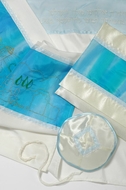Welcome to your source for designer Israeli Jewelry and Gifts. Buy and enjoy your chic and special jewels from the comfort of your home or mobile.
Welcome to our new site: https://sterlingsilverjewel.com
What is a Tallit - Tallis - Jewish Prayer Crawl
Israeli Jewelry - Israel Gifts
The Tallit – Jewish prayer shawl – is a commemoration of a kind of wrap that was worn by our forefathers.
After the Exile from Israel, they adopted the custom of the neighboring Bedouins of wearing the tallit as protection from the sun, and in this way the Tallit became an everyday garment.
The Tallit (talit, tallis), the Jewish prayer shawl, is a significant part in the lives of all Jewish men, and some Jewish women as well.
When praying the tallit brings a sense of spirituality on the person praying.
The Tallit is a classic Bar Mitzvah or Bat Mitzvah gift.
In the Book of Numbers (15:37-38) it is said:
And the LORD spake unto Moses, saying: speak unto the children of Israel, and bid them that they make them fringes on the borders of their garments throughout their generations and that they put with the fringe the borders a ribband of blue.
The fringes serve as a reminder of God’s commandments.
The Tallith is made of wool, cotton or silk, in which worshipers enwrap during prayer or when observing the Commandment of Tzitzith (fringes). Men wear a Tallith Katan (“small Tallith), which is also called Arba Kanfoth (four corners), during the day, but enwrap in a Tallith during Morning and Musaf Prayers. On Yom Kippur they enwrap in a Tallith during the entire day.
The custom of wearing a Talit varies from one ethnic community to another:
Ashkenazi Bar Mitzvah boys wear a Talit when they are called up to read from the Torah in the synagogue, whereas in the Sephardi community only married men wear a Talit. In some communities the bridegroom wears a Talit during the chuppah marriage ceremony, and it is also customary to enshroud the deceased with a Tallit.
A Talis is made of white wool and strict observers ensure their Talis is made of the white wool of sheep from Eretz Israel. The atara (decoration) made of silver thread has been added for adornment to the upper part of the Talis. The stripes are possibly a symbol of royalty in ancient Egypt, and perhaps even a commemoration of Joseph’s coat of many colors.
When a man enwraps in a Tallis he recites the blessing:
…who has sanctified us by thy commandments, and hast commanded us to enwrap ourselves in the fringed garment.
Tallitot and the Tefillin (phylacteries) have unquestionably become the most important of Jewish symbols.
Nowadays, Bat Mitzvah girls who wish to be called up to read from the Torah in the synagogue, and learn the portion of the week from the Bible and the Haftarah portion of the Prophets, enwrap in a Tallit and cover their heads when they are called up to read from the Torah. Adult women returning to their roots, too, celebrate bat mitzvah and enwrap in a Tallit when they are called up to read from the Torah. Bat mitzvah girls choose a kosher bat mitzvah Tallit that has fringes in accordance with Jewish religious laws, and an atarah, and has some fashionable features as well. Adult women choose a Tallit that has been specially designed for women and are called Tallit Nashim or women’s Tallitot. Enjoy!
Girls and women Israeli tallit - tallis
Israeli tallit - tallis
After the Exile from Israel, they adopted the custom of the neighboring Bedouins of wearing the tallit as protection from the sun, and in this way the Tallit became an everyday garment.
The Tallit (talit, tallis), the Jewish prayer shawl, is a significant part in the lives of all Jewish men, and some Jewish women as well.
When praying the tallit brings a sense of spirituality on the person praying.
The Tallit is a classic Bar Mitzvah or Bat Mitzvah gift.
In the Book of Numbers (15:37-38) it is said:
And the LORD spake unto Moses, saying: speak unto the children of Israel, and bid them that they make them fringes on the borders of their garments throughout their generations and that they put with the fringe the borders a ribband of blue.
The fringes serve as a reminder of God’s commandments.
The Tallith is made of wool, cotton or silk, in which worshipers enwrap during prayer or when observing the Commandment of Tzitzith (fringes). Men wear a Tallith Katan (“small Tallith), which is also called Arba Kanfoth (four corners), during the day, but enwrap in a Tallith during Morning and Musaf Prayers. On Yom Kippur they enwrap in a Tallith during the entire day.
The custom of wearing a Talit varies from one ethnic community to another:
Ashkenazi Bar Mitzvah boys wear a Talit when they are called up to read from the Torah in the synagogue, whereas in the Sephardi community only married men wear a Talit. In some communities the bridegroom wears a Talit during the chuppah marriage ceremony, and it is also customary to enshroud the deceased with a Tallit.
A Talis is made of white wool and strict observers ensure their Talis is made of the white wool of sheep from Eretz Israel. The atara (decoration) made of silver thread has been added for adornment to the upper part of the Talis. The stripes are possibly a symbol of royalty in ancient Egypt, and perhaps even a commemoration of Joseph’s coat of many colors.
When a man enwraps in a Tallis he recites the blessing:
…who has sanctified us by thy commandments, and hast commanded us to enwrap ourselves in the fringed garment.
Tallitot and the Tefillin (phylacteries) have unquestionably become the most important of Jewish symbols.
Nowadays, Bat Mitzvah girls who wish to be called up to read from the Torah in the synagogue, and learn the portion of the week from the Bible and the Haftarah portion of the Prophets, enwrap in a Tallit and cover their heads when they are called up to read from the Torah. Adult women returning to their roots, too, celebrate bat mitzvah and enwrap in a Tallit when they are called up to read from the Torah. Bat mitzvah girls choose a kosher bat mitzvah Tallit that has fringes in accordance with Jewish religious laws, and an atarah, and has some fashionable features as well. Adult women choose a Tallit that has been specially designed for women and are called Tallit Nashim or women’s Tallitot. Enjoy!
Girls and women Israeli tallit - tallis
Israeli tallit - tallis
Tweet
Tweet
Thank YouThank you for visiting our site and hope you will like our jewelry collection: silver jewelry, genuine Roman Glass jewelry, silver and gold spinning rings, Hebrew rings, gemstones necklaces and earrings,and much more.We strive to provide you the best customer service, in addition to top of the line quality products. We will be here for you with any question or need. Don't hesitate to contact us. Distributors and ShopsIf you have a shop or are a distributor, or want to sell our jewels and products at parties, working places, fairs - contact us and we will give you all relevant information and support.ShipmentShipping Information: by Registered Post or by EMS - expedited post.Secure PaymentsWe accept Paypal and main credit cards - Visa and Mastercard. You do not need to have a Paypal account in order to pay with your credit card, and you never share your financial information with anybody using PAYPAL SECURE PAYMENT! |
Tweet







